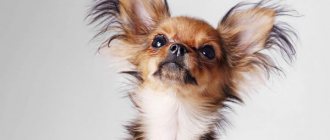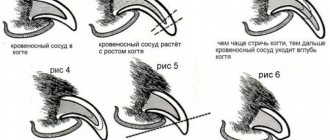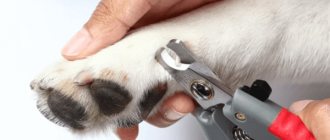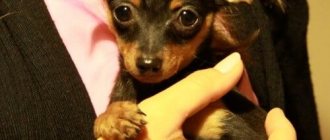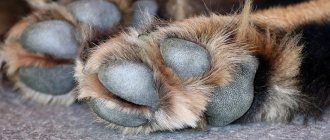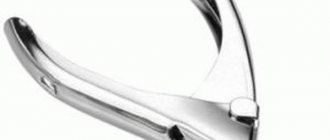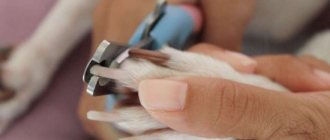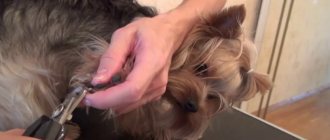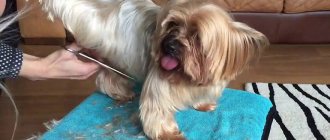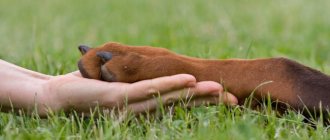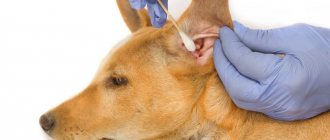Dogs' nails grow from birth and throughout their lives. Their condition is a direct indicator of health.
So, in case of a lack of vitamins, the claws begin to peel off. When immunity decreases, they become covered with a reddish coating of fungus. Excess protein gives them a reddish-brown color. Length and shape are important components that depend directly on the actions of the owner.
How many claws does a dog have? Why does a dog bite its nails?
Every owner of a four-legged friend has a serious problem with proper care for him. The main responsible activity is nail trimming. A dog's claws have a structure that is not typical for humans.
Dog claws have their own specifics: the hind paws have four claws and four toes, just like the front paws. Sometimes there is a fifth finger, but it is weaker than the others and its claw is not large. If a fifth claw appears on the hind legs, most dog lovers recommend removing it during childhood.
Dog's claws
When a dog spends a lot of time outdoors, walking along the street, the claws wear down on their own. But in winter, the hard ground is covered with snow and grinding is impossible, and some dogs do not walk outside for long, so trimming their nails is a mandatory procedure for dogs.
If this is not done in time, then they can get caught in them, get hurt, and the claw can rot. Among many dog breeders, dogs have a tendency to bite their claws. However, many do not pay attention to this. A clear deviation should be considered if the animal gnaws itself until it bleeds.
Bloody tracks in dogs
Why do dogs bite their claws: reasons
- The deplorable condition of the claws. If they are very long, they interfere with the dog's walking. The pet's fingers begin to hurt, and she naturally bites them to get rid of the pain.
- One of the reasons for biting claws is itching between the fingers. It is observed in the absence of proper hygiene, if the dog does not have enough frequent washing of its paws. You should always wash your pet's fur and paws after a walk.
- Significant damage to the skin on the paw pads. The cause of itching is caused by the paws of a sensitive dog touching hot asphalt in the summer, or chemicals that are used to cover the road in the winter.
- There may be a fungus or subcutaneous mite in the dog.
- The lack of necessary vitamins in a dog’s body is a separate reason for chewing paws. Poor dog nutrition, excess protein. All this leads the dog to neurosis and other consequences.
If you notice this behavior in your dog, you should definitely contact your veterinarian. He will take a scraping to check for the presence of parasites in the dog’s body. The clinic will help you remove unwanted hair and trim your dog’s nails correctly.
Trimming dog's nails
Nuances of the procedure
The first nail trimming procedure for dogs is the most exciting. If something goes wrong, it will be difficult to persuade the animal for subsequent haircuts. Talk to the animal, take its paws in your hands and hold it for a while. Then you can bring the instrument to it and if the dog does not show its dissatisfaction, then it is ready for the procedure.
Preparation
Trimming nails at home for the first time can be inconvenient, so it's best to get a second person to help. Prepare in advance all the necessary tools and materials:
- cutters;
- nail file:
- antiseptic;
- cotton pads;
- hemostatic agent;
- treat for the dog.
Before cutting your dog's nails, you need to prepare cotton pads.
Long-haired dogs have the hair on their paws and between the toe pads trimmed. Carefully examine your pet's paws and claws. There will be no problems with light claws. The pulp is clearly visible on them. With black claws it will be a little more difficult.
The timing of the procedure matters. It is best to trim your dog's nails after eating or after a long walk. You cannot manipulate an animal if it is scared or irritated. Calm your pet and only then proceed with the procedure. The same rule applies to the owner himself. The dog will immediately feel his excitement and begin to worry.
Find a suitable location. It should be well lit with a flat surface. Small dogs can be placed on your lap. The surface is covered so that the animal does not slide on it. The dog lies on its side, legs extended forward.
Trimming Features
At the beginning, it is determined where to make the first cut. With light-colored claws everything is clear; the pulp is translucent, starting at the base, and reaches almost to the end. The place where it is not there and needs to be cut. Hold the paw firmly in one hand and the tool in the other. Gently place your finger between the pads and secure with your thumb. Try not to touch the space between the dog's toes, otherwise the animal will feel tickling and begin to reflexively jerk its paw.
Pay attention to the shape of the claws. If the tip is curved, cut off only it, leaving the straight part
To prevent delamination of the claw, the cut is made from top to bottom, placing the tool perpendicular to the claw. The blade of the nail clippers is held at an angle of 45 0 C. After proper trimming, the dog should not “click” its claws on the floor.
How to trim a dog's black nails? In cases where the soft tissue inside the claw is not visible, you need to be extremely careful. By touching it, you will cause severe pain to the animal and will completely discourage you from continuing the procedure. Cut gradually, starting 5 mm from the edge. If the cut is dry and peeling, you can cut further, but gradually. When you see dark tissue on the cut, you need to stop. After trimming, each claw must be filed with a file to get rid of sharp edges.
Between trimming the claws on the hind and front paws, you need to give the animal a break. Two to three hours is enough for the dog to calm down and the procedure can begin.
Praise and reward
During the nail trimming procedure, speak to the animal in a soothing voice, pet it, and encourage it. You can give your dog a cookie, bone, or other treat. To make your haircut easy and relaxed, take breaks from time to time. Finally, praise your pet, tell him he did well, and bark another portion of the treat. By remaining calm during the first procedure, the dog will understand that nothing terrible is being done to it, and in the future it will continue to behave calmly.
Can a dog's nails be trimmed?
If a long nail is not trimmed promptly, it can cut into the skin and cause an infection. Improperly growing nails can cause lameness and problems with the pet's skeleton. Therefore, cutting a dog’s nails is not only possible, but also necessary for full-fledged life.
The structure of a dog's claw
Grooming procedures must be carried out in a veterinary clinic, but if your dog freely allows you to perform such a procedure on himself, then you can carry out the haircut at home. Before such a procedure, you should prepare the cutting tools and place. If you are performing this procedure on a puppy for the first time, be very careful about it. The puppy's subsequent fear will depend on your actions.
White claw on a dog
Before trimming, carefully inspect each claw. Only in white claws is the pulp clearly visible. If the nails are dark, trim them very carefully. After trimming, file the ends of your nails. Remove uneven cuts so they don't start to flake. And be sure to show tenderness to the dog, not aggression. Stroke his fur and prepare his favorite treat.
For what?
Is it necessary to trim a dog’s nails, because many dogs grind their nails down themselves during long walks on the asphalt. But not all dogs have their nails worn down when walking on a hard surface. And the fifth claws do not touch the ground at all and generally cannot grind off on their own
At first glance, overgrown nails may not seem like such a big deal, but there are still many important reasons why they should be trimmed.
Why cut:
- Long claws can curl inward and, growing even larger, dig into the animal’s fingertips, causing severe pain.
- Overgrown claws tend to crack and break. And, if the claw gets too caught on something, it can break anywhere, even near the base.
- Due to long nails, the dog cannot place its paw straight and keep it in a ball. Toes become twisted or curved unnaturally, which is especially harmful for puppies, as this can lead to deformation of joints and ligaments.
- The animal's balance is disturbed. The dog may skid to the side when running, and on a smooth surface it may slip and fall.
- Overgrown claws can be dangerous not only for the dog, but also for its owners. The dog may accidentally injure the owner with them or tear his clothes.
- For show dogs, overgrown claws are a serious fault for which their score in the ring is greatly reduced.
Therefore, if you do not want unnecessary problems for either your pet or yourself, you need to monitor the condition of its claws and trim them regularly.
Consequences of owner laziness:
Dog nail scissors - nail clippers
To trim your dog's nails, you need to prepare the following tools: Specialized scissors - a nail clipper. They have two varieties: scissors with sickle blades and guillotine.
The first type is suitable for cutting thick and strong nails in large dogs, and has a stopper to secure the claw. Guillotines are used to trim the nails of small and medium breed dogs.
nail clipper
Nail trimming scissors should only be purchased at a veterinary store. The material of the nail clipper is ideally stainless steel.
The size of the tool itself is also important. The best option would be to have rubber gaskets in the scissors. Which prevent your hand from slipping. Thus, eliminating irregularities and abruptness of movements. Never try to cut nails with regular scissors. They are not suitable for such a procedure.
Stock up on hemostatic agents. If you suddenly touch a claw or vessel, treat it immediately.
Preparation in the procedure
Nail trimming should be done as the growth grows. In specialized stores for animals, you can purchase nail clippers. Specialized scissors can be of two types - with sickle-shaped blades and in the form of a guillotine.
Crescent scissors look like tweezers with curved blades. Suitable for removing overgrown nails on large dog breeds. Such a tool must have a special limiter that allows you to adjust the opening width of the blades.
The guillotine type of nail clipper is preferable for carrying out the procedure for small, decorative and medium breeds of dogs.
There is a third type of tool that allows you to shorten overgrown claws. This is an electric scratching post equipped with a special attachment in the form of a grinding stone. When you turn on the electrical device, the grinding stone rotates, grinding the claws down to the maximum suitable length. A similar tool is used in grooming salons to give the animal’s claws a certain shape. Each owner determines for himself the main tool that will suit him.
To properly perform the nail trimming procedure, it is important to take care not only of the trimming tool itself, but also of additional tools. In addition to the nail clipper, you need to have the following necessary tools in the house:
- a tool for filing trimmed claws (a file with a hard coating);
- cotton pads;
- antiseptics (for example, a solution of potassium permanganate or peroxide);
- gauze napkins;
- hemostatic drugs;
- rubberized oilcloth or plastic bag.
Trimming of overgrown claws and further hygienic treatment is carried out over a spread rubberized cloth. This will allow you to easily remove small crumbs and particles of cut claws into the trash after the procedure.
How often should you trim your dog's nails? Where do dogs' nails get cut?
The frequency of nail trimming in dogs depends on:
- The dog’s lifestyle: how often is it outside, walking on hard surfaces and grinding its claws.
- Dog breeds: decorative dogs have a very short walking period, and their nails grow very quickly. Therefore, the frequency of pruning should be carried out once a week. In long-haired breeds, the claws are hidden under the hair and their growth may not be noticed in time. Therefore, a haircut should be carried out as soon as you hear the scratching sound of your pet’s claws on the floor.
- In other cases, claw trimming is carried out once every two months.
Nail trimming is carried out as a pet care procedure and to maintain health. It should be carried out by a qualified veterinarian. But if your dog is supportive and can patiently withstand your care, then circumcision can be easily done at home.
Can my pet's nails be trimmed?
Some owners, when getting a dog, are not even interested in how to properly care for it, and then various problems arise with the pet’s health. For example, many people do not know whether it is possible to trim a dog’s mustache, or whether it is possible to trim the nails of a domestic dog. This all relates to important points that the owner must know and follow. After all, how the pet will feel and look depends only on the owner. This is especially true for decorative small breeds that do not know how to take care of themselves and cannot do without human help. Therefore, we will consider in detail whether it is possible to trim the claws of a domestic dog, why this is necessary, what will happen if you leave overgrown claws, and how to trim claws at home.
Why does a dog need nail trimming?
One of the reasons why it is necessary to give a dog a pedicure is that the dog, unlike a cat, does not have the ability to grind on its own, for example, on furniture, carpet or other special surface. The pet is deprived of natural grinding, since it does not lead an active lifestyle, like street stray dogs. Animals that are constantly outdoors have their claws worn down on the asphalt, so they do not cause much harm. It is unlikely that there will be an owner who will run all day long with his four-legged friend on a hard surface. Even if you walk your dog often and for a long time, this will not help, since most likely these walks will be in parks where there is soft ground with grass.
But still, why is it so necessary to trim your dog’s nails? The problem is that long claws interfere with movement and negatively affect the dog’s gait. He cannot place his paw correctly, begins to experience pain when walking, and lameness appears. After some time, the joints of the paws acquire curvature, which will provoke diseases of the musculoskeletal system. And if the musculoskeletal system stops functioning correctly, therefore, paralysis of the limbs occurs. This is just one consequence of uncut nails; various other diseases, in most cases infectious, may also appear. Therefore, in order to avoid such terrible problems, you just need to regularly trim your dogs’ nails.
How often should a dog's nails be trimmed?
The duration of the procedure depends on the size of the breed. Control the length of your pet’s nails; to do this, you should carefully examine your dog’s paws. In small breeds they grow very quickly, but are deprived of natural wear, since they do not lead an active lifestyle, have little weight, and are often carried in the arms. Therefore, they need to have their nails trimmed once every two weeks. Representatives of large breeds have claws that grow more slowly, so they do not need pedicures often. It is advisable to carry it out once a month, and sometimes every two months is sufficient. But still don’t forget to inspect the paws. When moving, the dog makes a clicking sound and often bites its nails, which means it’s time to take up the instrument.
Consequences of neglecting nail trimming
In order for your four-legged friend to be healthy and able to run on the green grass, you need to monitor and care for him. Healthy, strong paws can only be with trimmed claws, otherwise the gait will be crooked and it will be impossible to stand the limbs straight. Let's look at the consequences of ignoring the process:
- Of course, the most important and important problem is the deformation of the limbs, which will lead to diseases of the spine.
- The dog will limp all the time and at the same time feel pain.
- The keratinized nail tissue will dig into the soft skin, injuring it. Therefore, there is a high probability of infection and then inflammation of the paws.
- On the dewclaws, which are higher than the rest, strongly overgrown claws can catch on some object, causing great injury.
- Long claws are dangerous because when scratching, for example, an ear or eye, a dog can harm itself. If injured, dirty paws will cause infection and further inflammation.
- If there are small children in the house, then the pet can scratch their delicate skin, again the possibility of infection.
- Over time, the nail will grow into the pad of the finger. Then you will have to go to the veterinarian, only he will be able to perform an operation to remove it.
- Damage to property and upholstered furniture has also not been canceled. Your friend will suffer from pain if the tip of the claw gets caught on the sofa and breaks off.
The dog won’t let you cut its nails: what to do?
Getting your dog into the habit of trimming its nails is not an easy task.
The dog will not allow you to cut your nails if you have ever been injured while trimming your nails. It is easier to accustom a small puppy to a haircut.
This procedure must be performed carefully, without violence. If you beat the dog and cause pain, grooming will turn into a hellish procedure every time.
Dog nail trimming by breed
To ensure that the nail trimming process goes perfectly, follow the following steps:
- Gently train your dog to use the nail clipper. To do this, show your pet the scissors for three to four days. If your dog behaves calmly, reward him for his diligent behavior with treats. Try clicking the scissors and checking the dog's calmness.
- The next step is to place a treat in a plate in front of your dog. Take the pet in your hands and click the nail clipper near its paws. Thank you for your calm behavior. If, nevertheless, the dog is afraid of something, turn its attention to its favorite game. After a week, return to this stage again.
- If your dog reacted calmly to the scissors during two stages, then it’s time to move on to the third. Place a plate of treats in front of your pet. Take the animal in your hands and, praising it, carefully begin to cut off the nails. Only the ends should be trimmed. After the procedure, release the dog to the saucer with treats.
Practice by trimming several nails every day. If the process is correct and painless, after two weeks you can remove the plate of treats.
Nail trimming tools
Another main condition for successfully trimming a pet’s nails is the availability of high-quality and specialized tools, as well as the availability of related items and dog hygiene products. To successfully trim your nails, you should use the following basic rules:
- Don't skimp on wire cutters. You need to buy a special nail clipper at the pet store. The most popular is the clipper, which looks like a guillotine. It is the easiest to use. When purchasing, you should check the blade - it must be well sharpened, since a dull blade can injure the dog’s claw. This clipper is good for trimming the tips of claws. In any case, when choosing a tool, you can consult with the pet store seller.
- Before carrying out the procedure, you should make sure that you have hemostatic agents at home in case of trauma to the vessels in your pet’s claw. If they are not there, then you can use regular flour - it will clog the vessel and stop the bleeding. But it is better to use pharmaceutical products.
- To ensure that the nail is even and smooth after the procedure, you can use a nail file.
- Peroxide and cotton swabs must be prepared immediately before starting the procedure.
- It is worth accustoming to trimming nails starting from puppyhood.
- The procedure should be carried out in a calm environment and as painlessly as possible for the pet, then the dog will not be afraid of trimming its nails.
Nail scissors
These scissors are similar in appearance to garden pruners, which have two blades, one of which is curved. Working with such a tool is easy and convenient.
Many models of such a tool have a limiter, which makes the haircut procedure itself safer. These scissors are only suitable for small breed dogs.
Guillotine
The tool received its name because of its external resemblance to this weapon and a similar principle of operation: a claw is inserted into the hole and by lightly pressing the lever, a mechanism is activated that cuts off part of the claw.
This tool comes in different sizes, so it is suitable for both small and large breeds.
Pug nail clipper
You can purchase a tool whose operating principle resembles a regular mechanical nail file. It will not only help to grind down the overgrown part of the dog’s claw, but will also get rid of bumps and snags and make the claw smooth without much effort.
These devices are mechanical and make a loud sound when operating, which can frighten your pet. This sound is a disadvantage of such machines, despite their ease of use. Well, it takes much more time to polish a claw than with simple trimming. If you carry out the procedure carelessly and touch the dog’s soft tissues, this can lead to serious injury to the paw.
The advantages of such a device are the presence of attachments of different hardness, which will allow you to process different types of claws of pets of small and large breeds.
How to trim the nails of a pug, spitz, toy terrier, Yorkshire terrier, Pekingese, chihuahua?
- If a pug under ideal and normal living conditions, the claws wear down on their own during walks. But some pugs do not like long walks, so trimming their nails is mandatory. Haircuts are often carried out with sedatives. Observe the pug, if he starts breathing heavily, stop grooming for a while and let him catch his breath.
- The behavior of the Spitz is also peculiar. But no matter how much he grinds his claws down during a walk, they still remain in place, as they are very strong. Carry out the procedure for trimming your Spitz's claws very carefully, cutting off only one millimeter.
Spitz
If you delay and skip trimming your little pet's nails, this will lead to an ingrown nail.
- Cutting the nails of a toy terrier is a very specific procedure. Start it at two weeks of age. The first time it is carried out in order not to injure the mother when feeding with weak and sharp claws. Toy terrier puppies have their nails trimmed every twenty days. As dogs grow, their nails are trimmed once a month. The toy terrier's nails should be trimmed in a timely manner to avoid drying out the nail plate.
- The York Terrier undergoes nail trimming twice a month.
- The Pekingese belongs to small-bred dogs and does not spend a long time on walks, so you should trim its nails regularly. Pekingese nails do not wear off on the asphalt; you should carefully monitor them to avoid ingrown or excessively rounded nails. Pekingese nails can be trimmed with a cat nail clipper.
Chihuahua nail trimming
- The Chihuahua is a very problematic breed of dog. Her care and hygiene are very specific and require a professional approach from a veterinarian. Professional and timely trimming of your pet's nails depends on multiple health problems. The procedure for trimming Chihuahua's claws is carried out once a month. For puppies once every two weeks. If such an animal's claws are not trimmed for a long time, they will grow along with the cornea. And this will lead to surgery.
Make sure that the dog does not begin to get rid of the claw itself, otherwise it may crack and break, and an inflammatory process will begin to develop in the resulting wound.
What you need to buy for your pet
When a puppy gets into the house of the people who have become its owners, it should already be provided with a minimum set of accessories. The baby should be comfortable and warm. To do this, you will need the following attributes that are so necessary for every dog:
- a lounger or a house - it is important to choose a size for growth, but at the same time, so that the baby is safe there;
- rubber toys, since puppies up to one year old change their milk teeth to permanent ones;
- bowls for food and water located on a special stand;
- comb made of natural stiff bristles;
- hydrogen peroxide (for wiping wrinkles on the face);
- eye drops (purchased in consultation with a veterinarian);
- shampoo for short-haired dogs;
- leash and collar;
- tray (if the puppy has not received all vaccinations, then walking on the street is prohibited);
- toothpaste and brush for dogs;
- nail clipper for dogs of the appropriate size;
- rubber bath mat (to prevent your pet from slipping in the bath).
Important! Buy bowls that come with a stand so that your gluttonous pug does not carry a plate of food all over the kitchen, but eats as slowly as possible.
A dog may need clothes for the cold season, but only when it is dirty or rainy outside. The overalls must be purchased after taking measurements of the puppy, or it is better to come to the store with your pet. Sometimes, instead of a leash, a harness is used to walk these dogs. But, no matter what you buy for a little pug, the most important thing you need to give your puppy is your attention and tender feelings.
How to trim the nails of a French bulldog, dachshund, or poodle?
- The French Bulldog's nails are hard. They are light in color, so the living part of the claw is clearly visible and has a pink color. Veterinarians recommend trimming the tip of the nail. Pruning should be done every ten days. If the claws are jagged, they can be easily filed. Puppies have their nails trimmed three weeks after birth.
- The most important procedure in caring for a dachshund is trimming its nails. This ensures the prevention of infectious diseases. When you hear your dachshund start tapping his claws on the floor, it’s time for a haircut. A dachshund's first nail trimming should take place at an early age. During summer walks, the dachshund wears down its nails, but in winter this is impossible, so nail trimming should be done every two weeks.
- The poodle has very sensitive nails. They should be trimmed regularly. The cut should be no more than 2 mm.
How to train?
Our pets really don’t like it when their paws are held and the pads and claws on these same paws are touched. But it is necessary to trim the claws, because if this is not done in time, the consequences can be very bad.
In this regard, the question arises: how to teach a dog to calmly endure this procedure, which is unpleasant from his point of view?
The most correct solution in this case is to teach the dog to trim its nails from puppyhood. Constantly being subjected to this manipulation, the puppy very quickly understands that there is nothing wrong with shortening his claws and over time he begins to calmly relate to this procedure.
ATTENTION! It is important to remember that trimming nails should not be accompanied by pain for the animal or at least unpleasant sensations
What to do if you cut your dog's nails until they bleed?
When trimming your dog's nails, your dog began to bleed - don't be upset. Next time, don't cut them so short. For such cases, the first aid kit of the home dog breeder and veterinarian should have basic hemostatic agents. If you see blood on your paw, immediately treat the wound with peroxide or iodine. If your dog starts whining, calm him down. After a painful procedure, please her with a treat. Try not to make such mistakes again, otherwise the dog will flatly refuse to trim his nails.
Basic Rules
A puppy must be taught to have a “manicure” from an early age. If you carry out this procedure regularly, trying not to cause discomfort or pain to the dog during it, then the pet will quickly understand that there is nothing wrong with trimming its claws, and will not break free and run away, or even hide, as soon as it sees The owner has a claw clipper in his hands.
Before you begin to shorten the nails of a long-haired toy terrier, you need to trim the hair between the dog's toes so that it does not interfere with the procedure.
It is very important to carefully examine the paw pads of any pet of this breed. If cuts, cracks or other damage are found, they must be treated with an antiseptic.
If splinters are found, they are removed and the wounds are also treated with a disinfectant.
If necessary, before the “manicure”, burrs, plant seeds and blades of grass stuck between the pet’s fingers are removed.
NOTE!
Before trimming the claws, you need to wash the animal’s paws and only wait until they are completely dry before you can begin the procedure.
The most convenient way to trim a toy terrier's nails is by sitting him on your lap or laying him down. It is not recommended to place the dog on a table or other high surface, from where it could jump or fall and be injured.
You should not shout at the animal or talk to it during the procedure in a threatening or irritated tone. The toy terrier should not feel fear or discomfort, otherwise next time he may become stubborn and refuse to trim his nails.
In order to facilitate the process, it is advisable to call one of your relatives for help - the assistant’s responsibilities will include holding the pet and diverting its attention.
If you cannot find helpers, then you can wrap the toy terrier in a thick towel or small blanket, leaving only his nose and one paw outside, which, after trimming the claws, should be hidden inside the “cocoon” and instead of it, another one, not yet treated, should be pulled out.
My dog broke a nail at the root, what should I do? How to stop a dog's nail from bleeding?
If a dog breaks a claw under unfavorable conditions and begins to limp, immediately check the integrity of the claws.
Follow the procedure step by step:
- Gently hold your pet's paw. Examine it and hold the dog close to you so that it feels your support.
- If bleeding occurs, wrap the paw with a bandage or towel to provide pressure.
- If the bleeding does not stop for more than ten minutes, then use a special pencil.
- Next, remove the broken claw using scissors. Cutting is painful, but will result in rapid growth of a new nail.
- The root should be treated with an antibiotic to avoid infection and minimize bleeding.
Pikinese
What to do if bleeding occurs
The length of the claw on different fingers differs and with a lack of experience, bleeding may occur due to accidental damage to the pulp. The dog experiences pain at this moment, begins to escape from the hands and avoids continuing to trim its nails. In this case, you need to lubricate the wound with iodine or hydrogen peroxide. Then apply a cotton pad soaked in a solution of potassium permanganate for 30 seconds.
Instead of treating with potassium permanganate, a layer of flour or talcum powder can be applied to the bleeding surface. Such measures are necessary to prevent wound infection. They should be carried out despite the animal’s resistance. Make sure that no water gets into the damaged area. To relieve stress, feed your pet his favorite food, give him more attention and affection.
If you have doubts about correctly performing claw trimming on your own, it is better to entrust this procedure to experienced veterinary clinic staff. When preparing your pet for an exhibition, the haircut should be done two or three days before the planned event. This will allow him to recover in the event of a cut accompanied by temporary lameness.
How to file and grind a dog's nails? What to do about an ingrown claw in a dog?
Activities for the care of dog claws consist not only of trimming, but also filing, grinding, and trimming the hair around the nail. A nail file is used for this procedure. If the dog is large, you can use a block of sandpaper to sharpen the nails. Some inventors use an acrylic file to file a dog's nails. For such pets, grinders are produced - electric grinding machines. If a dog's nail is ingrown, it should be removed immediately without damage or bleeding. Ingrown claws lead to injury to the dog and the development of purulent inflammation.
What to cut with?
You can take care of your claws using special pliers, also called nail clippers. They come in different sizes, and depending on the breed of the dog, you can always choose a convenient tool. It is better to use steel tongs: they do not bend, break, or become dull, which means the procedure will not be unpleasant.
You can also use a sharpening stone that resembles a nail file. They can not only shorten claws, but also treat burrs and sharp edges of claws after trimming.
Always keep hydrogen peroxide and bleeding stop agents (such as potassium permanganate powder) on hand in case you damage a blood vessel. To prevent this from happening, keep a close eye on your pet: timely hygiene will save both the owner and the dog from unnecessary problems.
Sign up for a nail trim - at one of the trusted clinics in Moscow and the region.
Nail fungus in dogs: treatment
- Detection and treatment of fungus in dogs should be timely.
- One of the popular methods of treating fungus is vaccinations.
- But the main factor in treating fungus is the breed of the dog.
- The use of antifungal drugs is popular.
- To reduce the likelihood of fungus developing in your dog, you should provide it with proper care and nutrition.
- Strictly observe the necessary hygiene rules.
- If you still observe the first signs of fungus in your dog, immediately contact a specialist.
Basic care guide – rules for pruning, what length should it be?
You can determine whether a haircut is necessary by the clattering sound that is heard when the dog moves along the floor of the apartment. Excessively long claws begin to bend, deform and peel. They prevent your pet from running and jumping and can cause injuries. The claw is not completely dead tissue; closer to the base it has blood vessels and nerve endings
It is important not to hurt them. In addition, along with the growth of the claws, the blood vessels located inside also grow.
Therefore, timely haircut will protect the dog from splitting, damage to blood vessels and bleeding. Before cutting a dog’s nails at home, you need to determine for yourself how long you can cut it so as not to injure or injure the dog. If the claw is light, then the blood vessels can even be seen in the light. From their end when cutting, you need to step back a little more.
How to trim black claws?
There are two ways to cut: There is another technique, but this can be used on dogs that have had their nails trimmed multiple times. The procedure itself should not cause anxiety for them. Then you can not immediately cut off the claw, but lightly press the trimmer handles. If under pressure the dog becomes anxious, then there is a possibility that you are very close to the nerve ending, you need to retreat.
What should you do if you had to cut your hair too short, how to stop the bleeding?
If you accidentally cut off more and the claw begins to bleed, you must immediately apply peroxide to cauterize the vessel. Do not forget that this is quite painful for the dog, so you need to calm him down before continuing.
Why trim your nails?
It is imperative to take care of your pet's claws. This procedure is not only cosmetic, but also medical in nature. Here are a few reasons explaining the need for this procedure:
- Long nails are very dangerous for the dog itself. When combing, she can seriously scratch herself.
- Long claws are dangerous because during intense running or play, your pet may accidentally tear off or break off a claw. This is fraught with severe bleeding, pain and infection.
- Long nails can prevent your pet from positioning his paw correctly. When walking, the four-legged animal will try to arch its paw so that its claws do not touch the asphalt or ground, in order to avoid pain. You may not notice it right away, but in the future, such an incorrect gait can lead to joint diseases.
- If you do not treat your dog's claws in a timely manner, over time they can grow into the flesh, and this is fraught with serious surgery.
- With his long claws, your friend can not only ruin the furniture in the house, but also scratch you during outdoor games.
- As your four-legged claw grows, so does the pulp inside. If you trim your claws regularly, the pulp will recede more and more towards their base. The less often you do this, the more likely it is that the pulp will grow very much. Then this procedure will become very complicated, because you will not be able to cut off enough of the nail to make the pet comfortable.
Additional care - dog pedicure
Dogs' nails need to be cared for throughout the pet's life. This is not about worshiping glamorous fashion, but about a vital necessity. Domestic dogs are losing many of the advantages that nature originally endowed them with many centuries ago:
- The way of life is such that there is no need to get food for yourself and use your own claws - which means they are not trained and not sharpened enough.
- Nutrition includes many components characteristic of an urban environment (in nature, such “additives” simply would not exist in dog food).
As a result, dogs' claws become loose, and their structure is often disturbed—proper care will solve the problem. Pedicure accessories will provide the nail plate with an even edge and a smooth surface. You can learn how to do a pedicure yourself, but you shouldn’t forget about professional services.
What you need to have in your arsenal:
- hemostatic powder and hygienic material (cotton pads, clean paper towels or napkins);
- a special file for dogs;
- electric polishing tool - grinder.
When using a grinder, the risk of injury is minimal
Using an electric grinder, you can adjust your claws all year round. Then they do not have time to grow, which means there is no need for a haircut.
An untrained dog is irritated by the vibration and characteristic sound of the device. But this can also be solved. One or two procedures, and the pet will resign itself, making sure there is no reason to worry.
Tips and tricks
Inexperienced owners are afraid to carry out the procedure for the first time. You can visit a veterinarian and learn from him. Or study the instructions and follow the advice of experts.
- For the procedure, choose a familiar environment. The dog should be calm and relaxed, not hungry. It's better to do this after a walk. If the animal is shy, there should be no strangers in the house.
- If the claws are black, it is difficult to determine where the blood vessel begins. Therefore, it is recommended to cut a few millimeters at a time.
- If the dog is nervous and tries to run away, it is better if another family member helps hold him. He should sit behind him and grab the pet by the neck with one hand and hold the paw with the other. It is important to stroke the dog and talk to it affectionately.
- Dogs have many sensory endings between their toes. Touching this delicate skin gives them an unpleasant sensation. Therefore, it is recommended to grab the finger not from the sides, but from above and below.
- It is especially important to exercise caution for pets with dark nails. The boundaries of the nail bed are not visible on them and it is easy to injure the vessel. Therefore, it is necessary to cut off little by little – a few millimeters at a time. It is recommended to stop when the tip stops flaking or becomes wet. You can focus on the hollow running below.
Your dog's nails need to be trimmed regularly. This is a mandatory hygienic procedure that will help avoid ingrowth and injury. If you don't take care of your pet's claws, they will grow back and cause discomfort. To carry out the procedure, it is important for the owner to prepare and follow the recommendations of veterinarians.
